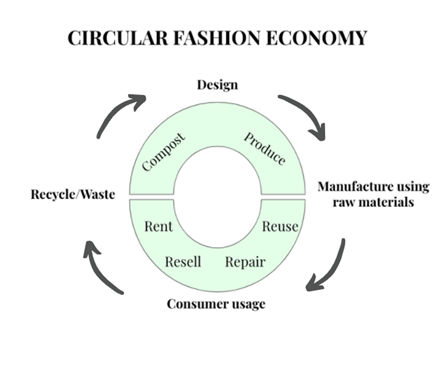Circular fashion is a term used to describe a regenerative system in which clothing, shoes, and accessories are designed and produced to be circulated throughout society for as long as possible until they are returned to the biosphere when we no longer have use for them. In simpler terms, it’s a unique approach for companies to reduce waste while also making the best use of their resources (both natural and artificial).
Sounds crazy right? According to Nosto’s Sustainability in Fashion Retail Report, 50 per cent of consumers who value sustainability are more likely to purchase clothes from companies that actively commit to that cause. This means that fashion brands must work twice as hard to carry out sustainability goals since it’s become a trending topic.
So what exactly does circular fashion entail?
Circular fashion was designed to eliminate waste by incorporating of recycling, refurbishing, reselling, and repairing. This ensures that garment materials are used to their maximum capacity before the recycling process begins.
There’s a lot of miscommunication on what to do with old, worn out clothing. Fast fashion or not, think about how quickly you go through a pair of leggings or a basic tee. Unfortunately, most of the time these frequently used staples end up in the trash, not properly disposed of. According to The Ellen MacArthur Foundation, “Every second, the equivalent of a rubbish truck load of clothes is burnt or buried in landfill. The fashion industry is one of the major contributors of plastic microfibers entering our oceans.” These are the effects of our economic linear model and how all if not most products consumed are based on a take, make, waste process.

The fact that it takes 1,800 gallons of water to grow cotton for one singular pair of jeans shows scope of the potential impact of improving fashion sustainability. Not only fashion brands, but consumers understand the vast value of resources and realise that we have to do much more to preserve them. The point of circular fashion is to keep the natural resources that have been extracted to produce clothing circulating until they’re so run down that they can be recycled into raw materials where the process starts over once again.
Key challenges with circular fashion
The only thing holding us back most fashion brands from the circular fashion system is how complex it really is. We’re looking at a process that can be extremely hard to scale especially as the demand increases. Not only that, but this idea is so abstract compared to our traditional linear model that it can be hard to convince consumers to adopt this process of sale and resale with recycling, repairing, and refurbishing occurring along the way. Another thing to look at is the increasing value of each product going through the cycle despite the fact that the clothing article might be damaged or stained. Because of this consumers may solely stick to buying cheap fashion and throwing it away after it rips within the first six months.
While there are various barriers holding back a more environmentally friendly cycle, it really all starts at the beginning. Brands and designers have the power to spark a chain reaction by being more aware of the materials and textiles they’re using. While it’s not required for them to use sustainable products, more and more consumers and major fashion brands like Stella McCartney, Eileen Fisher and Rag & Bone, are prioritising these products.

Time to reinvent the fashion industry
As we approach a period where the terms “sustainable” and “ethical” are used hand in hand with all things manufacturing, it’s essential to start brainstorming ways to integrate those ideas into your business practices it can be as easy as completing additional manufacturing certifications or switching up the textiles used in production. One small change can make a vast difference especially when it comes to saving time, energy, and resources.
This article has not been edited by Fibre2Fashion staff and is re-published with permission from makersvalley.net










Comments